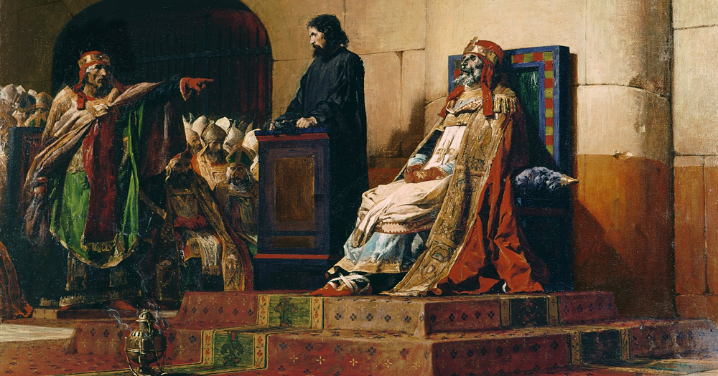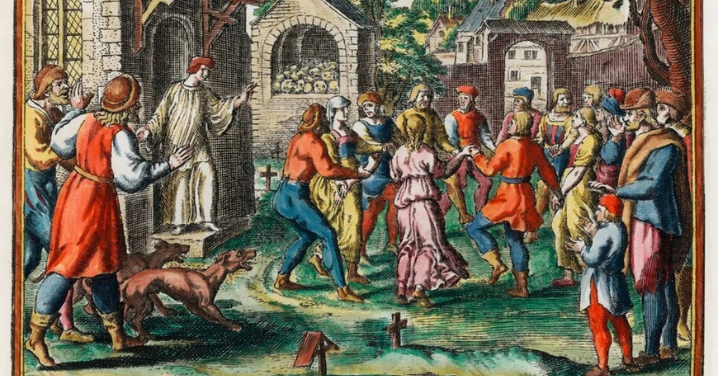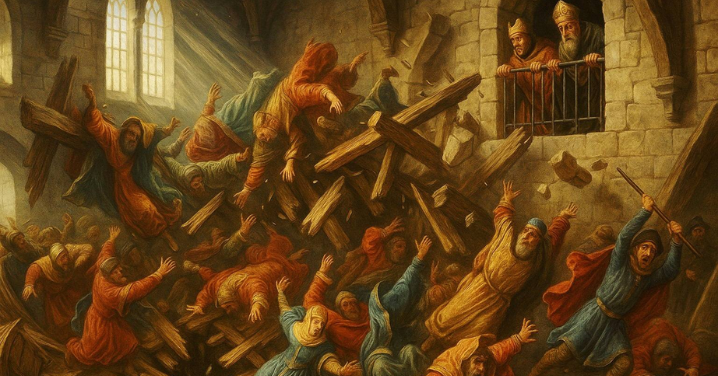
History is packed with absurd courtroom drama, but none comes close to the day the Catholic Church decided to dig up a pope who had been dead for months, prop him on a throne, and put him on trial. You read that correctly. In the year 897 the corpse of Pope Formosus was dragged out of its grave, dressed in papal robes, and forced to sit through a trial as church officials hurled accusations at him. This is not satire, not a dark sketch dreamed up by Monty Python, not a bad Netflix pitch. This is real history, known as the Cadaver Synod, and it might just be the strangest legal proceeding ever staged.
To understand how on earth this happened you need to know that the late ninth century papacy was basically a blood sport. Rome was not the centre of serene religious guidance, it was a swamp of political rivalries, power plays and outright corruption. Popes were being manipulated by powerful Roman families, Italian dukes and the Holy Roman Empire. Allegiances changed constantly, and everyone wanted to control the throne of Saint Peter because it meant influence over kings and emperors. Formosus, who had been pope from 891 to 896, was right in the middle of it. He made alliances with the wrong people, sided with one powerful family against another, and in the end left behind a mess of enemies when he died.
His immediate successor Pope Boniface VI barely lasted two weeks before dying himself, possibly poisoned. Then came Pope Stephen VI, a man with an axe to grind. Stephen had aligned himself with Formosus’s rivals and wanted to make absolutely sure his predecessor’s legacy was obliterated. But instead of just writing some nasty chronicles or quietly undoing Formosus’s decisions, Stephen decided on a stunt so grotesque it shocked even his contemporaries. He ordered Formosus’s body to be exhumed and put on trial for crimes committed while he was alive. Yes, a corpse trial. Because apparently in medieval Rome nothing said justice like yelling at a dead man.
So the body of Formosus, already decaying, was dragged out of its grave, dressed in papal vestments, and placed on a throne in the Lateran Basilica. Eyewitnesses claim the sight was horrifying. The corpse was rotting, the skin blackened, the hands stiff and skeletal. To complete the mockery, a deacon was appointed to act as the corpse’s “defense,” speaking on behalf of a pope who was literally falling apart. The court was filled with bishops and cardinals, and Stephen sat presiding like this was all perfectly reasonable. Then came the charges. Formosus was accused of perjury, of violating church law by holding multiple bishoprics at once, and of coveting the papacy. Imagine being dead and still being accused of ambition.
The trial was exactly as farcical as it sounds. Stephen screamed at the corpse, demanding answers. The deacon mumbled some half hearted defense. Witnesses were called to testify against a body that could not speak. The entire event became theatre, grotesque theatre, as bishops played along while the stinking corpse slumped further in its chair. It is said that at one point the body’s hand broke off, a grisly reminder that time waits for no courtroom. And through it all Stephen railed against his predecessor with the fury of a man who could not let go of a grudge.
Unsurprisingly, the verdict was guilty. Formosus’s papacy was declared null, his acts void, and his corpse was stripped of its robes. The fingers he had used for blessings were cut off. Then his body was dragged through the streets of Rome, jeered at, and dumped in a common grave. Not long after that it was exhumed again and thrown into the River Tiber. That should have been the end of it, but this was Rome in the tenth century and nothing ended cleanly. Locals who fished the body out of the river claimed miracles occurred. Suddenly the dead pope was being revered by the same city that had mocked him. The tide of opinion turned.
Stephen VI’s grotesque stunt backfired spectacularly. The trial had horrified the people of Rome. It made the church look deranged, vindictive and unstable. Within months riots broke out. Stephen was deposed, thrown into prison, and strangled to death. The papacy went into a tailspin of rapid turnover. In the following years later popes officially annulled the Cadaver Synod, declaring Formosus’s acts valid again, only for others to restore the condemnation, then reverse it once more. It became a papal tennis match, with each new pontiff using Formosus’s corpse as a symbolic pawn in their power struggles. By the time the dust settled the reputation of the church had taken a beating it would never quite shake.
The Cadaver Synod is one of those stories that makes you wonder how human beings ever took themselves seriously. Picture the scene without the historical context. A rotting corpse dressed in fine robes, propped up in a cathedral, while powerful men scream accusations at it. A deacon mumbling weak defenses for a body that is visibly decomposing. The smell in the air. The absurd pomp of bishops pretending this was justice. It is theatre, parody and horror in one. If someone staged it as a play people would dismiss it as unrealistic, yet it really happened. That is why it remains one of the darkest and strangest chapters of church history.
What makes it even more fascinating is how perfectly it captures the madness of power. Formosus was already dead. Nothing he had done could be undone by shouting at him. The trial achieved nothing tangible. But in the twisted logic of medieval politics, humiliating a corpse was a way of humiliating his allies, of stamping dominance, of making an example. It is both absurd and chilling to realise that human beings can invest so much energy into a grudge that even death does not end it.
Today the Cadaver Synod is often cited as the lowest point of the papacy, the moment when the institution lost any claim to dignity. It has become a symbol of how power corrupts, of how religion and politics can twist into grotesque spectacle. It is also, undeniably, one of the most unforgettable stories in history. Once you know about it you cannot unsee the image of that throne, that corpse, that mock trial. It sits in your mind like a bad dream. And maybe that is the most honest way to remember the Middle Ages. Not as a time of noble knights and holy rulers, but as a place where even the highest office in Christendom could be dragged through the muck in the most literal way imaginable.
The Cadaver Synod teaches us that human beings are capable of astonishing theatre when they are driven by spite. It is grotesque, tragic and laughable all at once. A reminder that sometimes the most powerful institutions in the world can look ridiculous when stripped bare. And it leaves us with the unforgettable image of a pope’s corpse, blackened and broken, being yelled at in court. History does not get weirder than that.



